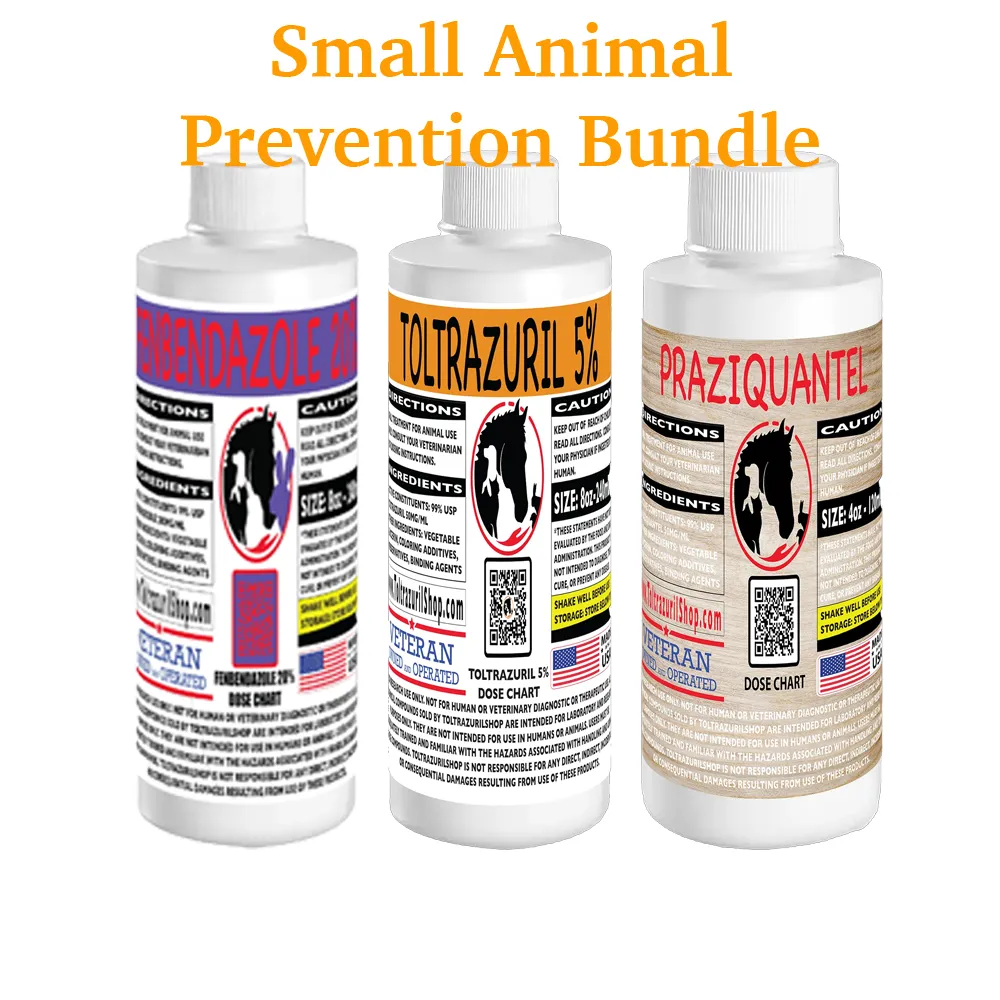Description
Small Animal Parasite Prevention Bundle — 4oz x 3 (Toltrazuril 5% • Fenbendazole 20% • Praziquantel 5%)
Why This Bundle?
Parasite control isn’t one-size-fits-all. Protozoa (like coccidia), nematodes (roundworms, hookworms, whipworms), and cestodes (tapeworms) respond to different actives. This bundle pairs three proven solutions so you can cover the full spectrum and rotate intelligently—ideal for breeders, kennels, catteries, foster/rescue programs, and multi-pet homes.
What’s Included (4 oz each)
1) Toltrazuril 5% (Coccidiosis Support)
Targets: Coccidia (Cystoisospora/Isospora; Eimeria in small livestock/exotics under vet guidance)
Use cases: Outbreak control in puppies/kittens, new intakes, weaning/stress periods, warm-weather spikes
Goal: Rapidly reduces oocyst shedding and supports normal stool consistency
2) Fenbendazole 20% (Broad-Spectrum Dewormer)
Targets: Roundworms, hookworms, whipworms; giardia support under veterinary guidance
Use cases: Routine nematode control, intake/quarantine protocols, rotational deworming
Goal: Reliable backbone for monthly or bi-monthly nematode management
3) Praziquantel 5% (Tapeworm Specialist)
Targets: Tapeworms (Dipylidium, Taenia; consult a vet for region-specific species)
Use cases: Flea exposure, rodent predation, quarterly “cleanout” in rotation
Goal: Efficiently clears tapeworm burden often missed by broad-spectrum wormers
Quality: Formulated from high-purity, COA-backed actives. Liquid format for easy measurement and mixing.
For Animal Use Only. Not for human consumption. Always consult your veterinarian for species- and weight-specific guidance.
What This Stack Accomplishes?
Full-spectrum coverage across protozoa, nematodes, and tapeworms
Rotation-ready to help reduce resistance pressure and avoid overusing a single active
Cleaner fecals & firmer stools during high-risk periods (weaning, transport, shows, boarding)
Flexible protocols for kennels, catteries, breeders, rescues, and multi-pet households
How to Use: Rotation Examples (General Guidance, Not a Rx)
A. Monthly “Core” Rotation (Dogs & Cats in Stable Homes)
Month 1: Fenbendazole 20% (core nematode control)
Month 2: Fenbendazole 20% again (maintain coverage)
Month 3: Fenbendazole 20% + Praziquantel 5% (tapeworm cleanout—especially if fleas/rodents)
Toltrazuril 5%: Add as needed during risk windows (new puppy/kitten, soft stools with suspected coccidia, post-boarding, or seasonal spikes). In some settings, run quarterly as a preventive pulse under vet guidance.
B. Breeder / Rescue Intake Protocol (Example)
Day 0–1: Fenbendazole 20% (intake cleanout for nematodes)
Day 3–5: Toltrazuril 5% (coccidia coverage during stress window)
Day 14: Fenbendazole 20% (break lifecycle)
Day 30: Praziquantel 5% (tapeworm pass)
Repeat fenbendazole monthly; repeat praziquantel every 3 months or when fleas/rodents present. Use toltrazuril in pulses during crowding, weaning, or any soft-stool/coccidia concern.
C. High-Risk Environments (Kennel/Cattery/Boarding)
Fenbendazole 20%: Every 4–6 weeks as your nematode baseline
Praziquantel 5%: Every 3 months (or sooner with active flea pressure)
Toltrazuril 5%: Short pulses for new arrivals/outbreak control; consider scheduled pulses every 8–12 weeks during peak seasons
D. Small Mammals / Backyard Poultry / Exotics
Use only under veterinary guidance. Species vary widely in sensitivity and dosing. Toltrazuril is commonly chosen when coccidia is the primary concern.
Tip: Pair your rotation with flea control to prevent tapeworm reinfection (e.g., add your preferred flea adulticide). Run fecal exams periodically to verify control.
Who It’s For
Breeders & kennels/catteries seeking a consistent, rotation-based program
Rescues & fosters managing frequent intakes and variable parasite loads
Multi-pet homes wanting a complete toolkit for common parasites
Show/working animals with travel-related exposure
Storage & Handling
Store at room temperature, capped tightly, away from direct light.
Keep out of reach of children. For animal use only.
FAQs
Can I give all three at the same time?
They’re designed to target different parasite groups. Many programs stagger doses to reduce GI upset and to verify response. Work with your vet on timing if you’re addressing multiple parasite classes at once.
How often should I run fecals?
For routine homes, 1–2× per year. For kennels/catteries/rescues, quarterly (or during outbreaks) helps you fine-tune rotation and verify efficacy.
Do I still need flea control for tapeworms?
Yes. Dipylidium cycles through fleas. Without flea control, reinfection is common.
Is this safe for puppies/kittens?
These actives are widely used in young animals under veterinary guidance. Always follow species/weight guidance from your vet.
Key Benefits (Quick Hit)
3-in-1 complete parasite toolkit (coccidia + nematodes + tapeworms)
Rotation-ready to help manage resistance
Liquid format for easy measuring/mixing
High-purity, COA-backed actives
Ideal for breeders, rescues, kennels/catteries, and multi-pet homes






Reviews
There are no reviews yet.